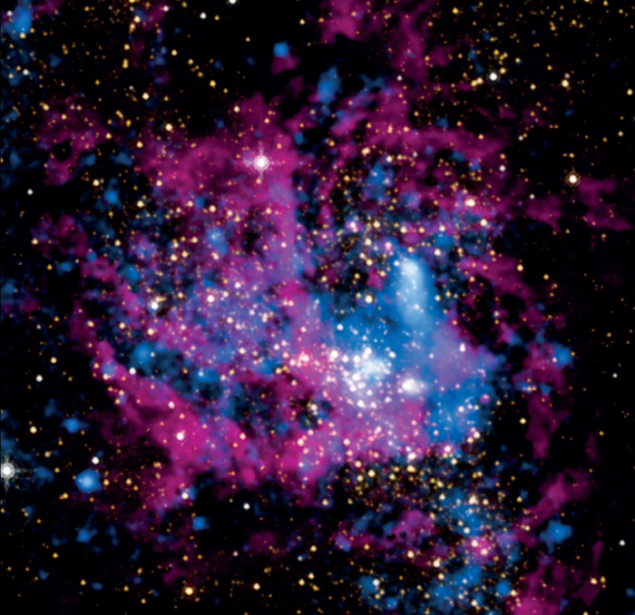
Image credit: X ray – NASA/UMass/D Wang et al., IR – NASA/STScI.
Researchers using NASA’s Chandra X-ray Observatory have found evidence that the normally dim region close to the supermassive black hole at the centre of the Milky Way flared up with at least two luminous outbursts during the past few hundred years. This was deduced from the light echoes of these outbursts on nearby gas clouds.
The motion of the stars at the centre of the Galaxy – which is seen from Earth as the Milky Way – has indicated the existence of a black hole with a mass of about four million times that of the Sun at the position of the radio source Sagittarius A*, or Sgr A* (CERN Courier November 2012 p15). This supermassive black hole is remarkably quiescent with an X-ray luminosity only about 10 orders of magnitude below the emission of active galactic nuclei. To explain such a weak emission, theorists developed a new class of models for which gas accretion onto a black hole would be radiatively inefficient. Nevertheless, despite its low emission, Sgr A* displays some activity in the form of flares. These occur almost daily and last less than about an hour. During a flare, the flux increases by a factor that ranges from a few to about a hundred at most, well below the emission potential of such a massive black hole.
X-ray astronomy began only 50 or so years ago, but there are ways to probe the earlier activity of this apparently dormant giant. One of them is to observe the X-ray emission of gas clouds surrounding the supermassive black hole. An outburst from Sgr A* could be reflected by the clouds towards Earth. The reflected light would then replay the original event with a delay, just as sound echoes reverberate long after the original noise was created. A beautiful example of such a light echo was witnessed around the flaring star V838 Monocerotis (Picture of the Month, CERN Courier June 2003 p13 and May 2005 p13).
A group of French astrophysicists with colleagues from the US and Germany used the high-resolution images from the Chandra satellite to investigate the past activity of Sgr A*. In data collected from 1999 to 2011, the team – led by Maïca Clavel from the AstroParticle and Cosmology (APC) laboratory in Paris – observed strong variations of the X-ray emission of clouds located near the Galactic centre. The X-ray echoes suggest that Sgr A* would have been at least a million times brighter had it been observed during X-ray outbursts of the past few hundred years.
This is the first time that astronomers have seen both increasing and decreasing X-ray emission in the same structures. Because the change in X rays lasts for only two years in one region and more than 10 years in others, this new study indicates that at least two separate outbursts were responsible for the light echoes observed from Sgr A*. These were likely to have been produced when large clumps of material – possibly from a disrupted star or planet – fell into the black hole. Some of the X rays produced by these episodes would then have produced X-ray fluorescence emission in gas clouds a hundred light years away from the black hole.
This study suggests that the recent quiescence of Sgr A* is only temporary and that the Milky Way’s black hole can flare up whenever enough matter approaches its event horizon. During the past summer, a cloud of gas was observed to have been ripped apart by the tidal forces near Sgr A*. It remains to be seen how much X-ray radiation the accretion of some of this gas might produce in the coming months. A much stronger past activity of the nucleus of the Galaxy is also suggested by the detection by the Fermi Space Telescope of the two huge gamma-ray bubbles blown out on both sides of the Milky Way (CERN Courier January/February 2011 p11).





